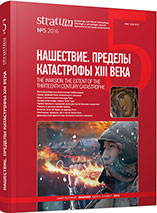Состав стекла артефактов из некоторых средневековых памятников Беларуси в контексте влияния татаро-монгольского нашествия на традиции древнерусского стеклоделия
Composition of Glass Artifacts from Some Medieval Sites of Belarus in the Context of Influence of the Tatar-Mongol Invasion on the Tradition of Early Russian Glassmaking
Author(s): Ekaterina P. Korolyova, Alexander N. Egor'kovSubject(s): History, Archaeology, Economic history, Middle Ages, 13th to 14th Centuries
Published by: Издательский дом Stratum, Университет «Высшая антропологическая школа»
Keywords: Belarus; Middle Ages; Tatar-Mongol Invasion; glass bracelets; glass composition; glassmaking traditions; assortment
Summary/Abstract: Glass items found on medieval (12th—13th c.) Belarusian sites, namely Mstislavl, Mogilyov and ancient Shklov (predominantly bracelets) is typical for the Early Russian tradition of glass manufacturing. This is evident from glass composition and typology of goods. Among them, the main adornments were bracelets made from lead glass or potash lead glass. A small part of artifacts consists of other types of imported bracelets manufactured from glass based on the ash of halophytes and predominantly blue colored. Presence of artifacts with other composition is also revealed.The Tatar-Mongol Invasion led to a decrease in production activity. A new stage of glassmaking was resumed later, as the society demanded new range of goods. This new stage was accompanied by a great number of imported goods made of halophyte ash in the East Mediterranean region. On the other hand, the technology of making of lead glass was not abandoned because of the ancient tradition widespread all over the Old Rus’.
Journal: Stratum plus. Археология и культурная антропология
- Issue Year: 2016
- Issue No: 5
- Page Range: 163-174
- Page Count: 12
- Language: Russian
- Content File-PDF

